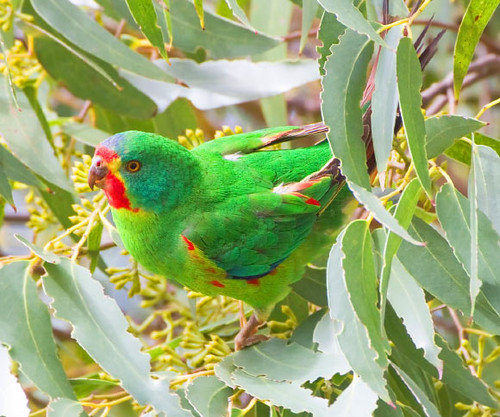Tasmanian Swift Parrot is on Brink of Extinction, Finds News Study
 Friday, April 3, 2015 at 11:54
Friday, April 3, 2015 at 11:54  Swift parrot (Lathamus discolor) on Bruny Island, Tasmania, Australia. Image by JJ HarrisonThe critically endangered swift parrot (Lathamus discolor) could become extinct within less than two decades, says a new study published online in the journal Biological Conservation.
Swift parrot (Lathamus discolor) on Bruny Island, Tasmania, Australia. Image by JJ HarrisonThe critically endangered swift parrot (Lathamus discolor) could become extinct within less than two decades, says a new study published online in the journal Biological Conservation.
The swift parrot is the only recognized species of the genus Lathamus. It is a slim, medium-sized parrot about 25 cm long. It weighs about 65 g and has a wingspan of between 32 and 36 cm.
It is bright green with red around the bill, throat and forehead. The red on its throat is edged with yellow. Its crown is blue-purple. There are bright red patches under the wings. One of most distinctive features from a distance is its long, thin tail, which is dark red.
The species is sometimes confused with lorikeets, most likely when seen flying overhead. In this situation the bird is then best distinguished by its flute-like chirruping or metallic ‘kik-kik-kik’ call.
Swift parrots are usually seen in small parties of up to 30 birds, or occasionally in larger flocks around sources of abundant food. There have also been a few reports of flocks numbering in excess of 1,000 birds.
The bird breeds only in Tasmania, and migrates to mainland Australia in autumn, undertaking the longest migration of any parrot species in the world.
The breeding range is always within eight km of the coast, largely restricted to an area of less than 500 sq. km. During the breeding season, nectar from the flowers of Tasmanian blue gum is the principal food source. During the non-breeding period, swift parrots feed extensively on nectar and lerp and other items from eucalypt foliage. The bird also eats psyllid insects and lerps, seeds and fruit.
The new five-year study discovered that swift parrots move between different areas of Tasmania each year to breed, depending on where food is available.
“Swift parrots are in far worse trouble than anybody previously thought. Everyone, including foresters, environmentalists and members of the public will be severely affected if they go extinct,” said Prof Robert Heinsohn of the Australian National University, who is the lead author on the study.
The new data was combined with a previous study that showed that the bird is preyed on heavily by sugar gliders.
Prof Heinsohn and co-authors predicted that the population of the swift parrots will halve every four years, with a possible decline of 94.7 per cent over 16 years.
“A moratorium on logging in swift parrot habitat is needed until new plans for their protection can be drawn up,” said study co-author Dr Dejan Stojanovic, also of the Australian National University.
In addition, Prof Heinsohn’s team has set up a crowdfunding project to pay for nest boxes to protect dwindling Tasmanian populations of the swift parrot and two other species of critically endangered birds – the forty-spotted pardalote (Pardalotus quadragintus) and the orange-bellied parrot (Neophema chrysogaster).
“Inaction could mean extinction. Tasmania is home to some of the most endangered birds in Australia, and they share a common threat – predation by the sugar glider. We are trying to do something about it,” Dr Stojanovic said.
The nest boxes cost between $30 and $50 to buy and install. They provide a safe-haven for birds and are valuable research tools for scientists as they undertake a risk assessment for orange bellied parrots.
The orange-bellied parrot is confined to only one population in the Tasmanian southwest World Heritage Area, but there is no information to assess whether sugar gliders pose a risk to this population.
“For species like the orange-bellied parrot and forty-spotted pardalote, we’ve only just scratched the surface of what can be done to save these species,” Prof Heinsohn said.

